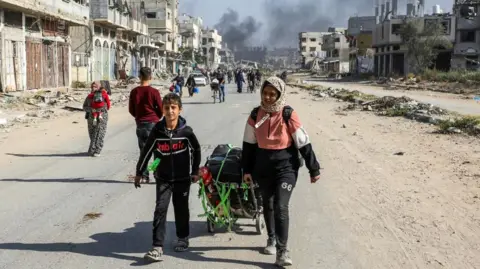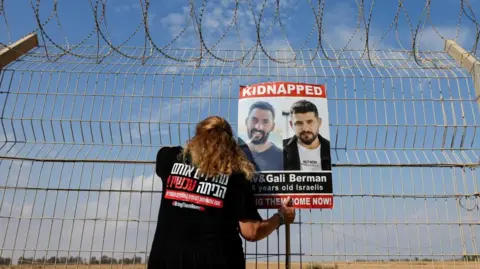Gaza Ceasefire: What Can We Expect?
 Reuters
ReutersIsrael and Hamas are said to be close to reaching an agreement to end the Gaza war and release Israeli hostages and Palestinian prisoners.
It would be a dramatic breakthrough in the 15-month war that began in October 2023 when the armed Palestinian group Hamas attacked Israel.
What would happen to a cease-fire agreement between Israel and Hamas?
The ceasefire agreement is expected to end the ongoing war in Gaza.
An exchange of hostages and prisoners is also expected.
Hamas took 251 hostages when it attacked Israel in October 2023. It still holds 94 captives, although Israel believes only 60 are alive.
Israel is expected to release about 1,000 Palestinian prisoners in return for the hostages.
How does a ceasefire work?
This ceasefire is expected to be implemented in three phases after it is announced.
Details are still being ironed out. It can be changed until the agreement is finalized.
First step
A Palestinian official told the BBC that initially 34 hostages – expected to be civilians – would be exchanged for Palestinian prisoners.
Three hostages will be released immediately, the rest of the exchange will take place within six weeks.
At this stage, Israeli forces begin withdrawing from populated areas in Gaza.
The Palestinian Authority said negotiations for the second and third stages of the ceasefire would begin on the 16th.
Second stage
In the second phase, the rest of the hostages – soldiers and conservators – will be released, in exchange for some Palestinian prisoners.
Of the 1,000 Palestinian prisoners Israel agreed to release, 190 were sentenced to 15 years or more. An Israeli official told the BBC that those accused of murder would not be released in the occupied West Bank.
At this point, Israel is now allowing displaced people in the south of Gaza to return to the north.
Almost all of Gaza’s 2.3m residents have had to flee their homes as a result of the conflict.
The third step
The third and final phase involves rebuilding Gaza – something that could take years.
The Israeli official said that during any ceasefire, Israeli troops would remain in a buffer or safe haven in Gaza.
 Reuters
ReutersWhat are the unanswered questions about the deal?
Getting to this point has taken months of direct and indirect negotiations, not because Israel and Hamas do not fully trust each other.
Hamas wanted a complete cessation of hostilities before releasing the hostages, which was unacceptable to Israel.
The cease-fire temporarily halts the war while the terms are met.
However, it is not clear whether the war is over for good.
Israel’s primary war objective is to destroy Hamas’ military and administrative capabilities. Even if Israel is badly damaged, Hamas still has the ability to mobilize and mobilize.
Nor is it known which of the hostages are alive or dead, or the whereabouts of all those still unknown to Hamas.
Hamas, on the other hand, has asked for the release of some prisoners, but Israel has said it has not. This is believed to include those involved in the October 7 attack.
It is also unclear whether Israel will agree to withdraw from the buffer zone on a certain date, or whether its presence there will be open.
Any ceasefire is likely to collapse.
A cease-fire between Israel and Hamas that ended previous hostilities was shaken by clashes and eventually collapsed.
The timing and complexity of this ceasefire means that even a small incident can turn into a major threat.
What happened on October 7, 2023 and what happened in Gaza?
Hundreds of Hamas-led militants have launched an unprecedented offensive in southern Israel, breaching the border fence and targeting communities, police stations and military bases.
About 1,200 people were killed and more than 250 hostages were taken to Gaza. Hamas has fired thousands of rockets into Israel.
Israel responded with a massive military campaign, first by air and then by land. Since then, Israel has attacked targets on the Gaza side by land, sea and air, while Hamas has fired rockets into Israel.
Israel’s offensive has devastated Gaza and caused severe food shortages, and aid is struggling to reach those most in need. According to Gaza’s Hamas-run health ministry, more than 46,600 people – most of them civilians – have been killed in Israeli attacks.








